A BRIEF HISTORY OF FRENCH ALPINE WINE REGIONS
The French Alps form a barrier that until modern times was challenging to traverse at any time and impassable in winter. However, their location was also a crossroads for people travelling both north to south and east to west, helping to explain why the French Alps ended up with such diverse grape varieties. The art of survival has always been a crucial skill for mountain dwellers; more recently wine has given them a chance to express their individuality.
The challenge in writing any history of the French Alps is that much of the area has been French for only a relatively short time. The province of Savoie (today’s departments of Savoie and Haute-Savoie) was formerly ruled by the House of Savoy – for history purposes the term seems best in the anglicized form. Savoy’s territory included, at various times, parts of Vaud in Switzerland, Aosta and Piedmont in Italy, and later became part of the Kingdom of Sardinia. Savoie, as we know it today, became definitively French only in 1860. Bugey was also for centuries part of the Duchy of Savoy, coming under French rule from 1601. The regions to the south – in today’s Isère, Drôme and Hautes-Alpes departments – formed the province known as the Dauphiné and came under French rule from 1457.
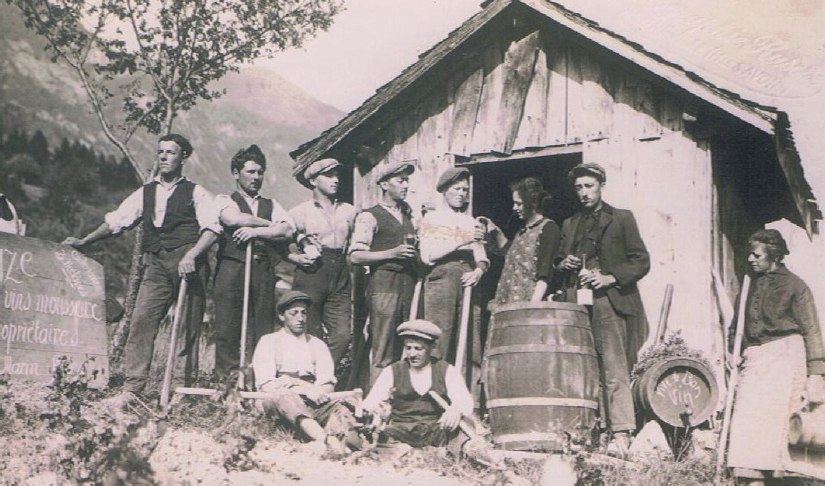
Harvesters in Ayze gathered by a vineyard hut in the early 20th century. Although the village name is cut off their sign, you can read ‘vins mousseux’ or ‘sparkling wine’.
The history begins with the pre-Roman establishment of the vine and subsequent Roman cultivation of vines to make wine for everyday consumption. Thereafter, the biggest influence on wine production became the Christian Church, with centuries of cohabitation of church, nobility and peasants. Democratization of the vineyards and increased plantings, linked with population growth, came in the 18th and 19th centuries, at the same time as advances in agriculture and science to make better wines. But this period also witnessed the great wine blights of the 19th century and ensuing disaster for the wine industry. These Alpine wine regions were at risk of disappearing into oblivion; survival of the vineyards here was in the balance right up until the 1970s.
Although Roman authors Pliny and Columella attested to the quality of the allobrogica vine, there are few mentions of wines from the French Alps as being truly memorable in quality. Travellers and writers through the ages have been simply overawed by the spectacular scenery in which vines thrived… an early 1611 travelogue, Coryat’s Crudities, by the British writer Thomas Coryat, waxes lyrical on seeing so many vineyards between Chambéry and Albertville:
‘I admired one thing very much in those vineyards, that they should be planted in such wonderfull steepe places underneath the hils, where a man would thinke it were almost impossible for a labourer to worke, such is the praecipitium [steepness] of the hill towards the descent.’
Old texts relate how noble travellers were sustained by the wines hospitably offered by monasteries and abbeys; in the 16th century, philosopher Michel Montaigne travelled through the Maurienne Valley and enjoyed wine probably from the Persan grape. Frangy’s virtues were proclaimed in the 18th century by another philosopher, Jean-Jacques Rousseau. But the wines did not reach the French courts, as, for example, Jura’s wines did; nor did they have a long-standing reputation like wines from Bordeaux, Burgundy or Champagne.
Thus until recently, wines from the French Alps were exclusively imbibed by the locals and the tourists. Only in the 21st century have wines from these mountainsides crossed borders and become properly valued locally too.
The Roman period and earlier
The French Alpine regions share a very ancient history of vine-growing. The Allobroges were the Gallic tribe living in a large area roughly between Geneva and the Rhône river, with their capital at Vienne, south of Lyon. The Allobroges were thus the first Savoyards and in wine terms are commemorated in the name IGP Vin des Allobroges. In the first century AD, Pliny and the agronomist Columella mentioned a red grape vine grown in the area, which Pliny baptized Vitis allobrogica and which may be a genetic forerunner of Mondeuse. Unlike the Mediterranean varieties brought by the Romans, the allobrogica vine resisted low temperatures and thus appears to have originated in the area. Archaeological finds in the French Alps have revealed evidence of winemaking and various references to the vine, such as an inscribed stone found near Aix-les-Bains, dating from the second or third century AD, and elsewhere amphorae and grape pips from that era.
Medieval times: influence of the Church and nobility
Christianity was established across the French Alps in Roman times, and following the collapse of the Roman Empire there was a succession of rulers, including the Burgundians and the Franks. During the late eighth and early ninth centuries, Charlemagne was an all-powerful emperor in western Europe. A devout Christian, his influence on agriculture was important and he ordered lands to be given to monasteries to grow crops, including vines to make wine for daily drinking. Monasteries became places where weary Alpine travellers could rest or sit out the vagaries of mountain weather; providing their guests with good wine was part of the Christian hospitality.
From the tenth century there is much evidence of vineyards established by the Church, often on donated land. The Augustinian Abbaye de Filly had vineyards in Marignan and Crépy by Lac Léman; the Benedictine priory of St-Philippe owned prized vineyards in the Combe de Savoie, and that of Ambronay was bequeathed vineyard lands in Bugey; the Carthusian monks of Arvières had vineyards in Seyssel and Bugey; and the Cistercian Abbaye de Hautecombe, on Lac du Bourget, established vineyards in Chautagne and Brison-St-Innocent. In this early period, bishops of Belley in Bugey, Embrun in Hautes-Alpes and Grenoble in Isère all took an interest in winemaking – the latter transported wine from the Combe de Savoie vineyards down the Isère river to Grenoble.
Pliny and the origins of Clairette de Die
Before the Romans, the Diois was occupied by the Gallic tribe called the Voconces (Vocontii), whose important towns included Die and Luc-en-Diois. The region has several archaeological finds proving that vines were cultivated, and in his Natural History Pliny described how the Voconces made wine. He wrote that grapes were harvested late and the must was chilled by plunging the jars into the Drôme river and leaving them there through the winter until the spring frosts. Undoubtedly the wine that emerged would have been cloudy and semi-sparkling from an incomplete fermentation, and the grapes could easily have been the very ancient, late-ripening Muscat variety used today. The description is certainly a forerunner of the Méthode Ancestrale, or Méthode Dioise, as it is called locally. It does not take much for the region to conclude that its sparkling wine predates Champagne… or any other sparkling wine.
The House of Savoy, founded at the beginning of the 11th century, has left its mark on the landscape in the many defensive forts built on hills overlooking important thoroughfares in the Aosta Valley and Switzerland’s Valais as well as in Savoie; ruins can be seen today close to vineyard areas, notably the towers of Chignin and the Château de Miolans. The Counts of Savoy also needed wine and this was often made for them by the Church. During the relatively prosperous period between the 12th and 14th centuries, vineyards expanded greatly, and historical documents mention many of those we know today; vineyards in Ayze, for example, are mentioned in Bonneville’s archives of 1279.
It was the Church that furthered the skills of farming vines and making wines, sometimes supported by nobility. The book Les Vignobles de l’Ain (2018) gives an account of wine production in Bugey’s Poncin between 1338 and 1350, provided by the vigneron who worked for the Sire of Thoire et Villars, a local family: it includes details of when to plant, how to tie up vines sur échalas, maintaining barrels and preventing the wine from turning to vinegar – and even how to sell the wine. By the 14th century, some nobles would designate different vineyard plots as being suitable either for noble or peasant land, and taxation on wine reared its head.

In the Diois, vine parcels in the village of Aurel were donated by various dignitaries to the cathedral in Die and its bishop.
It would be wrong to end the account of this period without mentioning two important stories from Savoie. The first concerns the collapse and landslide of Mont Granier in 1248, with tragic loss of life; it explains why today’s most-planted Savoie vineyards in Abymes and Apremont are not mentioned until some centuries later, when vineyards were planted on the rockfall. The second is the delightful story of the arrival in the early 15th century of the Altesse grape. It is said to have come from Cyprus through marriage with the Dukes of Savoy and subsequent planting near Jongieux – modern ampelographers insist this story is a myth.
Quality challenges in the post-medieval period
By the end of medieval times, vineyards had been established in most of today’s French Alps vineyard areas and far beyond, for example, all around Lake Annecy. But there was a growing problem with overproduction. Ahead of his time, in 1559 the Duke of Savoy, Emmanuel Philibert, implemented a Ban de Vendanges, which forbids vine-growers from harvesting before a decreed date, to ensure proper grape ripeness. But the Duke moved the capital of the Duchy of Savoy from Chambéry to Turin, which historians believe marginalized Savoie itself, and this affected the development of wine quality. Texts reveal that there were good wines to be found in good vintages, but there was a distinct lack of knowledge. In 1774, the Savoie noble and wine connoisseur Marquis Costa de Beauregard wrote an impassioned text about overproduction, urging the profession to take winemaking more seriously.
‘La mappe Sarde’ of 1730
The aim of the ambitious agricultural mapping of Savoie, conducted under the Kingdom of Sardinia, was to organize an efficient method of taxation. La mappe Sarde is a series of cadastral maps, which was saved from destruction and is now partly digitized. The map showed in incredible detail, plot by plot, the buildings and roads and it even differentiated the crops. These maps, which also show topography, are considered way ahead of their time and are both beautiful and fascinating for those who love maps, and invaluable for historians. In his 1998 book Les Vignobles des Pays du Mont-Blanc, Maurice Messiez devotes several pages to analysis of the Savoie vineyard areas at the time of la mappe Sarde. Here’s an example of his findings, translated and abbreviated:

This small extract of the mappe Sarde is of Jongieux and shows the Marestel hillside covered in vines.
‘In the case of Saint-Julien de Maurienne, whose 315ha of vineyards stretch along 6km of an alluvial cone situated between 600m and 800m, the breakdown of the plots was … [that] … 954 [peasant] owners came from 21 communes and about 250 of them came from more than 20km away to prune, weed, harvest and then sometimes take back the harvest in cow hides attached to the back of mules…’
Messiez’s book includes a chart for Savoie wine communes summarizing ownership (split between church, nobility and commoners/peasants). All the vineyard areas were far bigger than today and often their relative importance is reversed: Aiton and Ayze had more vineyards than Apremont or Jongieux, for example. For the fate of the vineyards of St-Julien de Maurienne, see here.
Although remaining mainly rural, industries developed in the French Alps, such as mining, watchmaking and others reliant on abundant water and wood resources. Consequently, vineyard areas expanded to supply the increasing population’s needs. The peak for vineyard plantings occurred in the middle of the 19th century and it is estimated that there were 22,000ha in Savoie/Haute-Savoie, 20,000ha in Ain (Bugey and elsewhere), 33,000ha in Isère, 6,000ha in Hautes-Alpes and 6,000ha in the Diois (part of Drôme). Almost all of the vineyards were used to make very ordinary red wine. Depending on the region, today’s planted areas are as low as 0.2–25% of these figures.
Two registers list the many Savoie grape varieties that were grown in the 19th century. The 1887 grape variety register was by Pierre Tochon (1819–1892), the president of the Savoie society of agriculture. He was prolific in his agricultural reports, which included one written in 1874 with a detailed chapter on wine production – his diligence helped to push up the quality of local wines. Another person of influence was Jean Fleury Lacoste (1803–1871), a Savoie vigneron who had been a Paris politician before returning to Montmélian – he founded and was president of the Chambéry agricultural society. Lacoste experimented with different vine training systems and after meeting Jules Guyot introduced his new Guyot system.
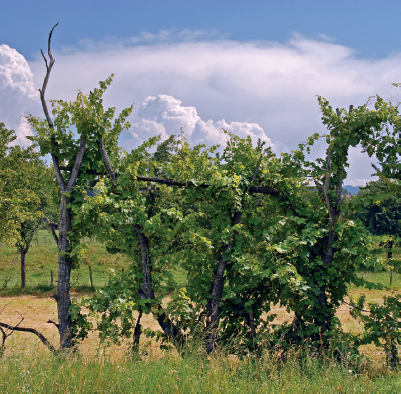
These vines, photographed in 2005 in Marin near Lac Léman, are trained in the style named ‘crosses’.
Dr Jules Guyot, in his 1868 report on the vineyards of France, Etudes des Vignobles de France, describes and illustrates the two families of vine training in Savoie. High training – as traditionally seen also in Italy and other Mediterranean areas – sometimes used trees for support and vines trained in this way would live for centuries, becoming huge in Savoie’s humid climate. Local high training styles included the hautains of Chautagnes and the crosses of Marin. Guyot noted that there was a plethora of training systems, including, especially around Montmélian, the form of Gobelet training we today refer to as sur échalas. He advocated low training for improved quantity and quality.
Sartot… Grangeon… Cellier… Cabane…
The vineyards in the French Alps are dotted with little houses or cabins, each region having its own style. The back cover of this book illustrates a grangeon in southern Bugey, and the photo below shows a cluster of these houses – almost a mini-hamlet – in the middle of the Monthoux cru in St-Jean-de-Chevelu, Savoie. These buildings – which the Savoyards call ‘sartots’ – had a serious function until at least the Second World War. ‘Sartot’ derives from the patois for a place ‘where you keep everything safe’ or ‘serre tout’.
Families who lived higher in the mountains, above where the vine could flourish, needed wine too. Those with enough money would purchase land to plant a few rows of vines in the closest vineyard area. The ‘Baujus’, the local name for those living in the Bauges mountains, farmed vineyards in the Combe de Savoie; villagers from Entremont-le-Vieux came across the Col du Granier to work vineyards in Apremont or Abymes; this is repeated across the French Alpine regions. Given that they needed to work their vineyards – in winter to prune and in summer to plough or fight disease, and then eventually to harvest – they needed somewhere not only to store their tools, but also to rest, eat, and possibly stay the night. The roofs were constructed to collect rainwater for mixing up vineyard sprays and for drinking. Some cabins were substantial, with a few rooms to live in and perhaps even to make and store the wine (a cellier); others were no more than the size of a large shed. Today, many are being restored to preserve the beauty of the vineyard landscape.
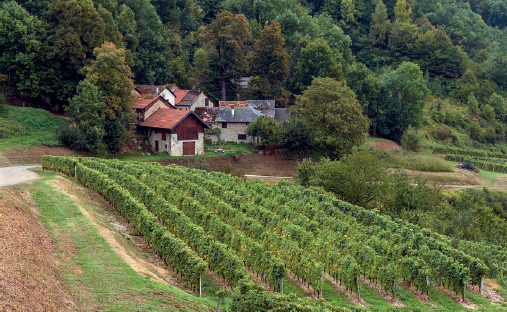
A century of upheaval
The century from 1850 to 1950 was difficult everywhere in the French wine world. For the French Alps the most significant threats to survival were:
•fungal diseases: oidium (powdery mildew), then later downy mildew and in some places black rot, arrived between 1850 and 1890 and caused serious crop reductions.
•establishment of the railways: this allowed wines from the south of France, and later from French-controlled North Africa, to be easily transported to main towns – the wines were stronger in alcohol and cheaper in price, hitting the market for local wines hard.
•phylloxera: known in France since 1865, the louse was identified in the vineyards of Hautes-Alpes in 1868 and reached Savoie by 1878. Phylloxera steadily wiped out the vineyards in its path, but once grafting vines onto American rootstocks was discovered, it gave a chance to replant vineyards using newly learned methods. On the brighter side, Savoie developed a good reputation for its for vine nurseries, which specialized in grafting.
•the huge loss of human life in the First World War: following a decline of rural, and especially mountain, populations who had left to find jobs in the cities, after the war, depopulation increased further. Many high-quality vineyards that had been replanted after phylloxera were abandoned, particularly those on the higher and steeper slopes, which were hardest to work.
After phylloxera only those grape varieties that were known to give a reliable crop were replanted in any quantity; and many vineyards were replanted with lesser-quality hybrid varieties, which did not require expensive grafting. This legacy had a long-lasting effect on the diversity and quality potential of French Alpine vineyards.
In the early decades of the 20th century, as elsewhere in France, there were various attempts at delimiting vineyard areas, setting down in law local production methods and wine styles, with the main aim of protecting the names against fraud (which had been rife since the end of the 19th century). To this end, syndicates of growers in each area were set up, with the Diois and Seyssel among the first to do this. Producers of Seyssel and Clairette de Die sparkling wines were also almost certainly the earliest in the French Alps to adopt bottles rather than barrels. Whereas Clairette de Die conquered local markets, Royal Seyssel, a sparkling wine brand created by Monsieur Varichon and Monsieur Clerc early in the 20th century, was perhaps the first local wine to cross the seas, notably to the UK and to the US.

The Royal Seyssel label has remained largely unchanged for a century.
The first AOCs in France were established in 1936. In the French Alps, Clairette de Die and Seyssel were the first AOCs in 1942, followed by Crépy in 1948. For Savoie as a whole, quality was much less homogenized. In the 1950s, the first step was to achieve the lesser VDQS designation, also obtained by Bugey in the department of Ain, where the concept of using the term Vins du Bugey had only just appeared.
Until as late as the 1970s there were hardly any vine-growers who lived solely from their vines: either they had another job or they were mixed farmers. Largely uneducated, making and selling wines was beyond most of them. The establishment of wine co-operatives saved the day for many. The first to be established here were in the wine areas of Isère’s Coteaux du Grésivaudan (none survives) and in the Gap/Tallard area of Hautes-Alpes, with only the Cave des Hautes Vignes surviving. The Cave des Vins Fins de Cruet (today’s Cave de Cruet) was established in the Combe de Savoie in 1939; a rival co-operative in Montmélian, set up in 1947, bottled and sold wines from all over Savoie, but closed in the 1990s. Two more have survived from the 1950s: the Cave de Chautagne in Savoie, renamed Le Vigneron Savoyard (after merging with the smaller Apremont co-operative of that name), and the very successful Cave de Die, which as Jaillance today controls 70% of the output of Clairette de Die.
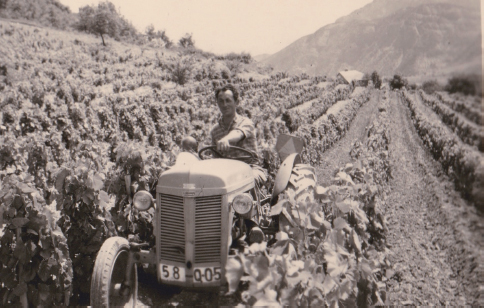
Louis Allemand, grandfather of Laetitia Allemand, proudly driving a tractor in his Hautes-Alpes vineyards in the 1960s.
Finding new markets and making modern wine
In the post-war period, the AOC Clairette de Die developed hugely thanks to the advent of refrigeration and pressure tanks, which meant the ancestral method could be used to make a consistent and stable sparkling wine. Cerdon in Bugey benefited from the same technology. The Diois, in particular, used the simple offer of their speciality sparkling wines, allied with good distribution, to develop new markets across France via supermarkets, which were emerging as wine suppliers.
An important turning point for Alpine viticulture came in the 1960s and 1970s. The challenges of working the steep hillsides had gradually pushed the vineyards down onto the flatlands, many of them not ideal for quality winemaking. Being able to mechanize vineyards with tractors, combined with the use of chemical fertilizers, herbicides, insecticides and anti-fungal sprays, led to more cost-effective yields. Many vignerons I have spoken to who were born before the 1950s are clear that without the advent of chemical treatments, the Alpine vineyards would not have survived.
The rise of the ski tourism industry was hugely significant for Savoie and was linked with a need to achieve the AOC – a badge of approval much appreciated in France. Countless well-established Savoie vignerons told me how the arrival of the AOC in 1973 encouraged them to move from polyculture to a focus on vines. Youngsters wanting to become vignerons were encouraged to study wine, most going to wine schools such as Beaune or Mâcon in Burgundy, or Belleville in Beaujolais, although there were courses closer to home in La Motte Servolex in Savoie, and Belley in Bugey. In the 1970s Bugey too set out its stall for local markets, vignerons encouraging visitors to their tasting rooms. And everywhere, increased prosperity brought more local restaurants to supply.
The Savoie AOC was a good marketing tool, and encouraged better and more consistent wines – for one thing, yields, which had sometimes reached over 100hl/ha for Jacquère, were reduced. But not everything was good about it. The list of permitted grape varieties excluded many historically important grapes, such as Douce Noire, and this has led to a long battle to rehabilitate these grapes. The Savoie AOCs remain complicated, with a high number of crus for such a small vineyard area. Over the years, just two have been dropped, where only privately owned vineyards remained – Charpignat, near Lac du Bourget, known for the rare Cacaboué grape, and Ste-Marie d’Alloix in Isère, known for Verdesse.
By the end of the 1980s Savoie wines had gained their (now unwanted) image as wines ideal to drink on a ski slope – preferably within one year of vintage. Yet from this period emerged some strong characters, insisting on doing things differently. Noël Dupasquier in Jongieux stuck to making wines that were bottled late and made to age, especially his Roussette de Savoie Marestel; Michel Grisard, Louis Magnin and the late Charles Trosset in the Combe de Savoie proved that Mondeuse could be a serious red wine; Jean Masson and his son Jean-Claude developed a good reputation for their Apremont wines by reducing yields and harvesting Jacquère later; Albert Belluard effectively saved the Gringet grape in Ayze and his son Dominique proved it could be used to make fine still as well as sparkling whites. And in Chignin, André and Michel Quenard, alongside several others, planted more Bergeron (Roussanne) on the best, steepest slopes to offer a serious white alongside their usual Jacquère.
Bugey also had some key vignerons bucking the trend for making cheap, ordinary wine. In the northern part, Philippe Balivet, Alain Renardat-Fâche and Raphaël Bartucci, among others, were making real Cerdon rather than a carbonated copy; in the south, the Peillot family, Patrick Charlin and Fabrice Gros championed Altesse and also Mondeuse, while Caveau Bugiste and Domaine Monin revived the Manicle cru. In Hautes-Alpes, Marc Allemand was insisting there was a quality future for his region’s wines and helped achieve its Vin de Pays designation.
French Alps vignerons in the 21st century
The first two decades of the 21st century have again provided challenge and opportunity in equal measure. In wine production the concerns are climate change and the need to focus more on the environment. A decline in traditional markets and the availability of increasingly good quality wine from around the world have pushed sales down for some producers and profits have been squeezed. But most vignerons realize that making better quality wine is the answer. And the growing interest in obscure grapes and wine regions, as well as lighter wines, present opportunities for French Alpine producers. Better-educated, well-travelled vignerons are gradually taking over, determined to shake up ideas.
Bugey finally obtained the AOC in 2009 and in Isère and Hautes-Alpes, once both important wine regions, a handful of vignerons are reviving the reputation of the wines through the IGP system. Meantime, the Diois is battling a decline in interest for Clairette de Die, but trying to launch new products, like rosé, not always successfully – see here. And in Savoie, while some established producers revitalize their range with a new AOC for Crémant de Savoie, it is the organic vignerons who are creating a buzz outside the region. A handful of young organic vignerons across the French Alps follow the French natural wine trend, shunning AOC. For Savoie, as well as Bugey and Isère, demand from export markets is on the increase.
The next chapter covers in more detail a few of the movements and people that have specifically influenced the French Alps wines we drink today. And I explore the 21st-century challenges and opportunities in the last chapter of Part 3.
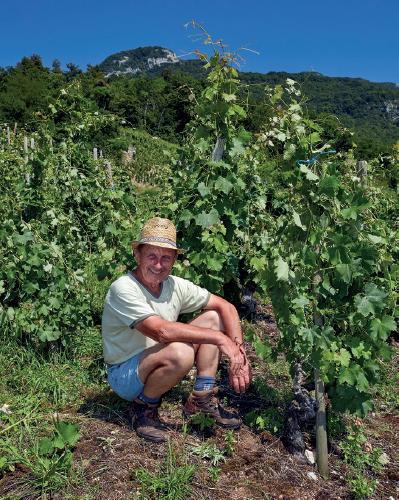
Noël Dupasquier with his centenarian Altesse vines on the Marestel slope in Jongieux.